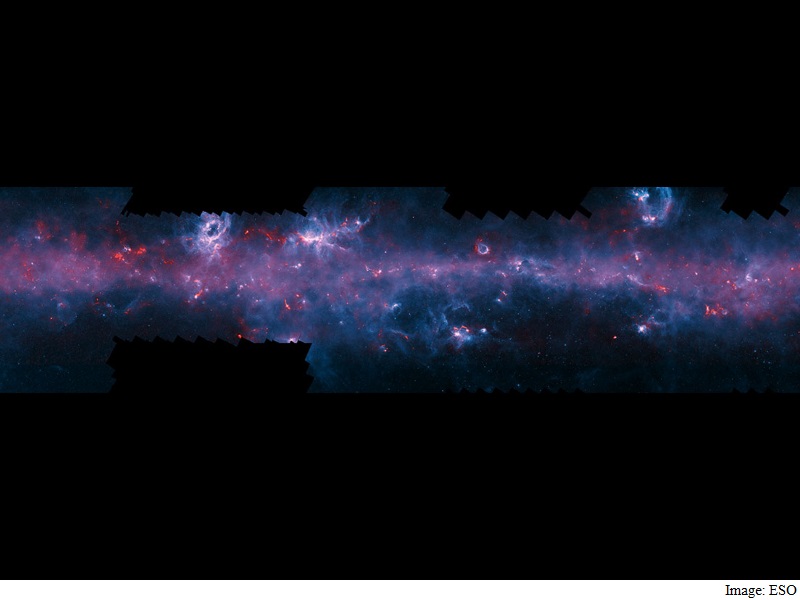- Home
- Science
- Science News
- Map of Milky Way's Star Forming Gases Lend a Stunning View of the Galaxy
Map of Milky Way's Star-Forming Gases Lend a Stunning View of the Galaxy

The map - which was combined with previously collected data - is the result of the APEX Telescope Large Area Survey of the Galaxy (ATLASGAL). The APEX (Atacama Pathfinder EXperiment - there are a lot of acronyms involved) studies the southern sky at submillimeter wavelengths - between infrared light and radio waves.
"Seen in visible light, these regions of the Universe are often dark and obscured due to the dust," the European Southern Observatory's website explains. "But they shine brightly in the millimetre and submillimetre part of the spectrum. This wavelength range is also ideal for studying some of the earliest and most distant galaxies in the Universe, whose light has been redshifted into these longer wavelengths."
APEX uses nearly 300 high-tech sensors kept at just 0.3 degrees above absolute zero to monitor minuscule changes in temperature. When incoming radiation meets one of the telescope's many detectors, it notes the resulting temperature increase and uses it to map cold swaths of gas and dust.
The new map covers an area of sky 140 degrees long and 3 degrees wide, which is more than four times the size of ATLASGAL's previous release. In the video and image above, you can see the ATLASGAL data in red. The background image - the blue stuff - comes from shorter infrared wavelength observations made by Nasa's Spitzer Space Telescope. The European Space Agency's Planck satellite provided more data to complete the picture, contributing the fainter red structures shown. The Planck satellite covers the entire night sky, but it does so at a lower resolution than APEX surveys the southern sky - which is where we can observe our galactic center.
© 2016 The Washington Post
Catch the latest from the Consumer Electronics Show on Gadgets 360, at our CES 2026 hub.
Related Stories
- Samsung Galaxy Unpacked 2025
- ChatGPT
- Redmi Note 14 Pro+
- iPhone 16
- Apple Vision Pro
- Oneplus 12
- OnePlus Nord CE 3 Lite 5G
- iPhone 13
- Xiaomi 14 Pro
- Oppo Find N3
- Tecno Spark Go (2023)
- Realme V30
- Best Phones Under 25000
- Samsung Galaxy S24 Series
- Cryptocurrency
- iQoo 12
- Samsung Galaxy S24 Ultra
- Giottus
- Samsung Galaxy Z Flip 5
- Apple 'Scary Fast'
- Housefull 5
- GoPro Hero 12 Black Review
- Invincible Season 2
- JioGlass
- HD Ready TV
- Laptop Under 50000
- Smartwatch Under 10000
- Latest Mobile Phones
- Compare Phones
- Honor Win RT
- Honor Win
- Xiaomi 17 Ultra Leica Edition
- Xiaomi 17 Ultra
- Huawei Nova 15
- Huawei Nova 15 Pro
- Huawei Nova 15 Ultra
- OnePlus 15R
- Asus ProArt P16
- MacBook Pro 14-inch (M5, 2025)
- OPPO Pad Air 5
- Huawei MatePad 11.5 (2026)
- Xiaomi Watch 5
- Huawei Watch 10th Anniversary Edition
- Acerpure Nitro Z Series 100-inch QLED TV
- Samsung 43 Inch LED Ultra HD (4K) Smart TV (UA43UE81AFULXL)
- Asus ROG Ally
- Nintendo Switch Lite
- Haier 1.6 Ton 5 Star Inverter Split AC (HSU19G-MZAID5BN-INV)
- Haier 1.6 Ton 5 Star Inverter Split AC (HSU19G-MZAIM5BN-INV)

















